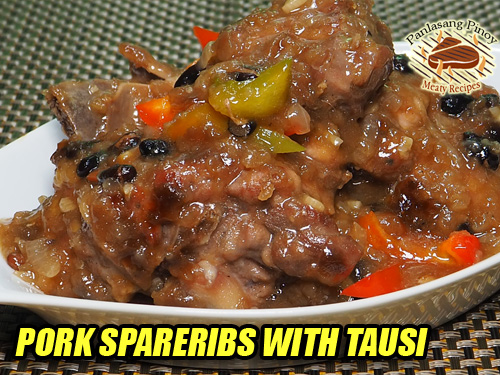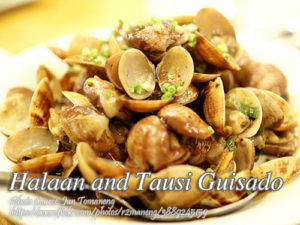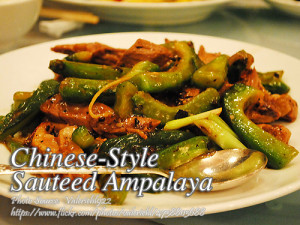This recipe is an Asian dish which I think is also adopted to Filipino taste buds. This recipe contains fermented black soybeans or salted black beans and there are also some Filipino dishes that contains this kind of beans and It’s called in Chinese as “Douchi”. What makes this more interesting is how easy and quick on cooking this dish.
Spareribs with Tausi: A Taste of Home and a Dose of Nostalgia
During my childhood, there was never a family dinner without a generous, filling dish centered on the table. One of those comforting meals that makes me rush back in time is spareribs with fermented black beans. This dish is quite humble, yet profoundly flavorful; the house itself permeates the whole with the powerful aroma of garlic and onions and the simmering soy sauce. I learned how to cook it from my uncle, who swore by a few secret techniques to really bring out the best flavors.
What makes this dish extra special is the unique balance of Asian and Filipino influences. It’s an easy recipe to follow, and the result is a savory, comforting plate of tender meat that goes well with steamed rice. My best friend once remarked how similar this dish was to the food she had in a local Chinese restaurant, but just with a little twist from the Philippines, making it even more familiar to our palate.
Perfect Harmon of Taste: Black Fermented Beans
This Chinese fermented black bean dish, at its core, is douchi, which is a source of fermented beans used in the main ingredient. These little pieces of flavor are filled with umami and depth that add to the dish. My sister introduced me to the wonderful versatility of fermented beans when she used to live in Hong Kong for a while; those beans used to stir-fry and braise in the meat.
We also have our version of fermented beans in Filipino cuisine, but truly impressive is the Chinese influence in this dish. The black beans add a hint of saltiness that brings out the already strong flavors in the pork, making every bite tastier and richer. Best part? It’s quick and easy to prepare, perfect for busy weekdays or when you want to whip something delicious without spending hours in the kitchen.
This Simple Cooking Recipe with Tasty Results
It is what makes it a staple in my house to prepare because the main ingredient, pork ribs, is marinated in soy sauce for that deep, savory flavor to absorb. From my uncle, I learned that letting the ribs sit in the marinade for about 30 minutes lets the flavors be infused and really penetrate the meat, making it even more tender and tasty after cooking.
After marinating, I dust the ribs lightly with cornstarch. This trick from my best friend’s mother renders the meat wonderfully crisp once it hits hot oil. The crackling sizzle of ribs frying in the skillet is like music to my ears, signifying you are well on your way to a delightful meal. Add the browned garlic and onions, then introduce the real star of the dish: the assertive black beans. Stir them together and there will be an aromatic fragrance that bobs its head around the kitchen, foreshadowing what will likely be a lip-smacking affair.
A Pinch of History: The Origins of Tausi Recipes
Although fermented black beans are perhaps most famously used in Chinese cuisine, they have been a part of the regular diet of many Filipinos for decades. Douchi has, for nearly two millennia, been added to Chinese dishes to create flavor; this commodity was likely introduced into the Philippines through either centuries of trade and migration between the two cultures.
I also love how these beans transform rather simple ingredients to make something extraordinary. There are quite a number of traditional Filipino dishes that feature fermented beans, and even though they take on different forms and names across regions, these beans bring out that sense of umami that Filipinos gravitate towards, making it just a natural fit for our taste buds.
A Versatile Dish for Any Occasion
It is probably one of the funniest parts of this dish-its adaptability. You can really fiddle with the recipe according to what is available in your pantry. Some days I totally forego the bell peppers and add a handful of chili flakes to give it a little heat. Other times, I substitute the pork with chicken or beef depending on what I have on hand.
If you prefer a thicker sauce, like me, just mix a little more cornstarch in water and add this to the sauce toward the end of the cooking time. My uncle always said that if one likes sauces rich and clingy, the sauce should be thick enough to coat the back of a spoon. I have carried that little tip along with me through the years.
Serve over hot rice, ensuring that enough steaming hot rice accompanies every piece of the food. Soaking in all the savory sauce may take place within the rice, bringing about a perfect combination of flavors and textures in each mouthful. One can find pleasurable enjoyment over dinner with family or friends sitting around the table and telling tales of laughter.
A Home-Feeling Dish
Every time I make this dish, it reminds me of the days of Sunday lunch with my family. We would all wait impatiently for my uncle to bring it out in the dining room, surrounded by the whiff of garlic and soy sauce in the air, the crackle of spareribs from the frying pan. It’s one of those sensory memories that lingers long after the meal is done. Even to date, whenever my best friend comes over, she asks me to make that particular dish, insisting that it reminds her of the good old days.
If you are a novice in cooking, don’t be intimidated by the name of this recipe. It’s actually an easygoing recipe for beginners, and soon after cooking it once you would realize just how effortlessly something so delectable can be prepared. Spareribs with black beans is one of those dishes that look and taste as if you spent hours in the kitchen. But finally, it’s a real quick and easy meal for which people will be asking for seconds. So gather your ingredients and, ready for the preparation of this dish that not only has a rich flavor but also rich in history.
How to Cook Spareribs with Tausi (Fermented Black Beans)
Ingredients
- 1/2 kilo pork spareribs
- 1 Tbsp. soy sauce
- cornstarch for coating spareribs
- 1/4 cup cooking oil
- 4 cloves garlic crushed
- 1 pc onion chopped
- 2 Tbsp. salted fermented black beans
- 1/2 Tbsp. rice wine
- 1 Tbsp. soy sauce
- 1 Tbsp. cornstarch dissolved in 1 cup water
- 2 pc red and green bell pepper cubed
- 1/2 tsp. salt
- 1 Tbsp. sugar
Instructions
How to cook Spareribs with Tausi:
- Cut spareribs into 2 1/2 inch pieces and marinade in soy sauce for about 30 minutes.
- Coat ribs with cornstarch then heat cooking oil in a skillet and fry spareribs in high temperature until brown.
- Add in the onions, garlic and black beans then stir and cook for 5 minutes.
- Pour in rice wine, soy sauce and cornstarch dissolved in water. Simmer for 35 to 45 minutes or until meat is tender. Add more water is the liquid is drying out.
- Add the red and green bell peppers and season with salt and sugar.
- Simmer until the sauce is thick. Serve hot.
Video
Notes
Cooking Tips:
Marinate for Maximum Flavor
Marinating the spareribs in soy sauce for at least 30 minutes helps tenderize the meat. The flavors are able to penetrate deeper into it. If you have more time, you can try marinating it for up to an hour for even better results. This would ensure that every bite is infused with savory goodness and would make the taste even better.Coat with Cornstarch for a Crisp Texture
Light dusting of spareribs with cornstarch before frying creates a crispy crust on the outside, keeping the inside quite juicy and tender. Cornstarch serves to lock in the moisture of the ribs so that you can enjoy delightful texture. It's a relatively minor step that'll add a very nice restaurant-quality touch without causing extra hassle.Control the Thickness of the Sauce
To get a rich, saucier sauce, mix a little bit more cornstarch with water and add it during final simmer. Stir the mixture often, so it doesn't clump and evenly thickens the sauce. Add just the right amount of water and cornstarch to coat the ribs.






Hi Sarah Jane, you can use white wine or sweet sherry. You can also use a little bit of cider vinegar as an alternative.
What if I don’t have rice wine? Any other alternative?
What if I don’t have a rice wine? Any other alternative which I can easily find?